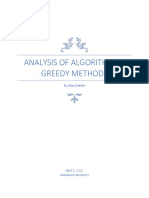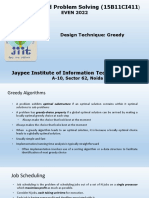0% found this document useful (0 votes)
42 views42 pagesLec06 Greedy Algorithms (Part 1)
This document covers greedy algorithms, including their properties, applications, and specific examples like the Fractional Knapsack Problem and Dijkstra's Algorithm. It explains the greedy method as a technique for solving optimization problems by making the best immediate choice at each step, and discusses scenarios where greedy algorithms yield optimal solutions versus when they do not. Additionally, it outlines the implementation of these algorithms and their efficiency in various contexts.
Uploaded by
yijoebackupCopyright
© © All Rights Reserved
We take content rights seriously. If you suspect this is your content, claim it here.
Available Formats
Download as PPTX, PDF, TXT or read online on Scribd
0% found this document useful (0 votes)
42 views42 pagesLec06 Greedy Algorithms (Part 1)
This document covers greedy algorithms, including their properties, applications, and specific examples like the Fractional Knapsack Problem and Dijkstra's Algorithm. It explains the greedy method as a technique for solving optimization problems by making the best immediate choice at each step, and discusses scenarios where greedy algorithms yield optimal solutions versus when they do not. Additionally, it outlines the implementation of these algorithms and their efficiency in various contexts.
Uploaded by
yijoebackupCopyright
© © All Rights Reserved
We take content rights seriously. If you suspect this is your content, claim it here.
Available Formats
Download as PPTX, PDF, TXT or read online on Scribd
/ 42



















































































